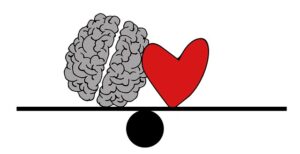I absolutely love DBT’s emphasis on balance. We need balance in nearly everything we do. Balance improves our conversations, when we alternate between listening and talking. Balance allows us to walk, dance, and play our favorite sports, and balance helps us make effective decisions about our finances, relationships, and leisure time. Finding balance in any aspect of our lives increases our peace and wisdom.

One of the core mindfulness skills in DBT, wise mind, encourages us to practice finding balance between emotion mind and reasonable mind. On one side, you have emotion mind, the seat of fiery passion and impulsive actions. If you’ve ever done something without thinking about it or let your emotions get the best of you, you likely have experienced emotion mind. On the other side, reasonable mind is cool and calculated, full of logic and devoid of feelings. If you’ve ever completed a task in a get-it-done-now manner without consideration of your own or another person’s emotions, you likely have experienced reasonable mind too.
I found a great analogy for wise mind while watching Cartoon Network’s Steven Universe. The show features holistic and musical episodes which touch on topics such as trauma, friendships, and shame. I highly recommend it. Many of the characters are known as gems, and they have magical abilities including being able to fuse with other gems to become stronger. One of the main characters is named Garnet, a strong and wise gem who has the ability to see into the future. At the end of season 1, viewers learn Garnet is actually a fusion of Ruby and Sapphire. Ruby is a hot-headed, loud talking, fiery fighter, whereas Sapphire has a cold, calculating, and distant demeanor. When they fuse into Garnet, Ruby’s passion and Sapphire’s level-headedness create the strength, reason, and wisdom needed to protect Earth and all its inhabitants.

When emotion mind and reasonable mind come together, they form a mental place we call wise mind. Wise mind is the integration of opposites: Ruby and Sapphire, emotion and reason, hot and cold. In wise mind, you can engage with your emotions without becoming overwhelmed by them, and you can make logical decisions that honor your feelings.
Sounds too good to be true, right? But wait, there’s more!
Everybody has wise mind. Each person, without exception, has an internal pre-programed magic 8-ball which allows them to act in their best interest. What’s the catch? It is sometimes very hard to find wise mind. In fact, I have found wise mind to be one of the most challenging DBT skills to practice because it is so hard to know if I’m “doing it right.” I notice thoughts such as, “this is ridiculous,” “I’m literally the one person on the planet who does not have wise mind,” and “how do I know if this is wise mind or if I’m just trying to fool myself?” In combination with other mindfulness skills and lots of practice, finding wise mind can become a more accessible and effective way to make decisions. Next time you find yourself struggling with a decision, try taking a moment to access wise mind. Take a few deep breaths. On the inhale, ask wise mind a question. On the exhale, listen for the answer. The tricky part is to avoid giving yourself the answer. You may feel silly at first, and with enough practice you can use wise mind to find the balance you need to build your life worth living.
Resources:
Dr. Marsha Linehan introduces wise mind: Click Here
Behavioral Tech describes the process of finding your wise mind (Part 1 ): Click Here
Behavioral Tech describes the process of finding your wise mind (Part 2 ): Click Here

